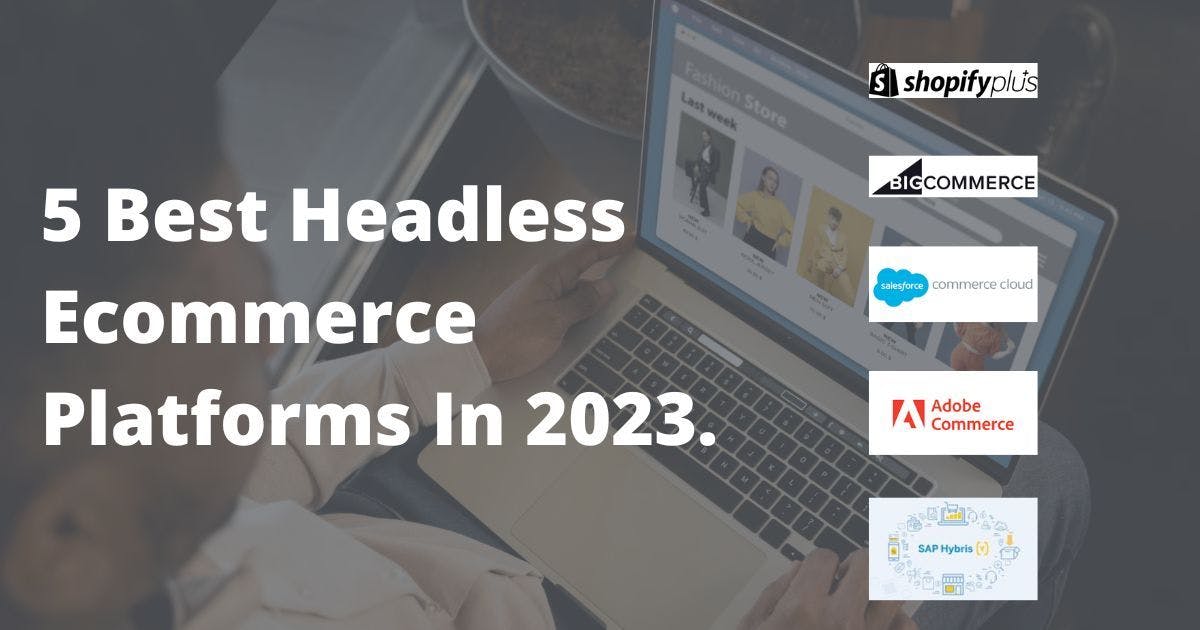5 Best Headless Ecommerce Platforms In 2023

By Pritesh B
Posted | 12 min read
Headless commerce is a type of ecommerce platform that separates the storefront from the back-end infrastructure which communicate through an API. This allows for greater flexibility and scalability in the development and deployment of e-commerce websites and applications.
The term is often interchangeably used as headless cms or headless content management system.
One of the key benefits of headless architecture over traditional commerce is that it allows for the use of any frontend technology, such as React or Vue.js, to build the UI. This means that developers are not limited by the capabilities of the e-commerce platform they are using and can create a more customized and engaging user experience.
The use of a headless commerce architecture allows for a greater degree of control over the performance and scalability of the website or application.
Another benefit of headless commerce solution is that it allows for the use of multiple channels to sell products, such as social media, chatbots, and voice assistants. Using a headless commerce approach can help businesses reach a wider audience and increase sales.
New age headless commerce platforms
The new age headless commerce platforms offer businesses a range of benefits, including greater flexibility, scalability, and security, as well as the ability to reach customers across multiple channels.
Whether you're a startup or an enterprise-level organization, these platforms can help you create powerful e-commerce experiences that meet the needs of modern consumers.
Below are most popular headless commerce platforms which are out in the market. Let's go -
Shopify Plus
Shopify Plus is a powerful e-commerce platform designed for large businesses and high-volume merchants which uses headless commerce or other open-source ecommerce platforms. It is built on the same technology as Shopify but offers additional features and capabilities for businesses that need more advanced functionality.
Features
In terms of features, it offers a wide range of tools and capabilities to help businesses grow and manage their online store. Some of the key features include:
Custom checkout
Allows businesses to create a custom checkout experience for their customers, including the ability to add custom fields, collect additional data, and more.
Advanced reporting
Provision for businesses with detailed insights into their sales and customer behavior, allowing them to make informed decisions about their business.
Custom apps
Ability for businesses to create custom apps that integrate with their online store, providing additional functionality and capabilities.
Multi-language and multi-currency support
Enables businesses to sell to customers all over the world, in their own language and currency.
Steps to create a Shopify Plus account
- Create a Shopify Plus account by signing up on their website.
- Choose a theme for your store and customize it to match your brand.
- Add your products and organize them into collections.
- Set up payment and shipping options for your store.
- Add pages such as "About Us" and "Contact Us" to your store.
- Set up a domain for your store, if you haven't already done so.
- Test your store by placing a test order and reviewing the checkout process.
- Launch your store and start promoting it to potential customers.
- Continuously monitor and analyze the performance of your store, and make changes as needed.
- Seek help from Shopify Plus support if you need it.
| Advantages of Shopify Plus | Disadvantages of Shopify Plus |
|---|---|
| Designed to handle high traffic and large amounts of sales, making it a great option for businesses that expect to grow quickly. | Shopify Plus is significantly more expensive than the regular plans, making it difficult for new brands to utilize it. |
| Provides access to enterprise-level features and support | Longer time to go live to production as there is a significant learning curve with technology |
| Wide range of pre-built templates and themes to make it professional headless storefront in no time | Shopify Hydrogen is the tech stack which Shopify uses for its headless offerings, it is still in its early stages with limited community support |
| Developer friendly APIs and thorough documentation. |
BigCommerce
BigCommerce is a leading headless ecommerce solution that allows businesses to create a customized front-end using their own website or mobile app, while still taking advantage of the platform's robust headless solution.
With its easy-to-use interface and wide range of features, BigCommerce is an excellent choice for businesses of all sizes looking to take control of their e-commerce operations.
Bigcommerce supports both headless and traditional commerce stack which makes it easy for merchants to switch if they feel that headless may not be the right direction for their business.
Steps to set up your BigCommerce account
Sign up
The first step in creating your BigCommerce store is to sign up for an account. You can do this by visiting the BigCommerce website and filling out the registration form.
Choose a template
Once you have created your account, you will have the option to choose from a variety of customizable templates for your store. You can also opt to design your own unique website
Add your products
Next, you will need to add your products to your store. This can be done by creating product listings, which include details such as product name, description, price, and images.
Configure your store settings
Once your products are added, you will need to configure your store settings. This includes setting up your payment gateway, shipping options, taxes, and other important settings.
Customize your store design
After your store settings are configured, you can customize the design of your store. This can be done by editing the template you have chosen or by customizing the design yourself.
Add apps and integrations
BigCommerce offers a wide range of apps and integrations that can be added to your store to enhance its functionality. This includes apps for marketing, analytics, and customer engagement.
Launch your store
Once you have tested your store and made any necessary changes, you can launch it to the public. This can be done by clicking the "Launch Store" button in your BigCommerce account.
Promote
After launching your store, you will need to promote it to attract customers. This can be done through various marketing channels, such as social media, email marketing, and paid advertising.
Monitor and optimize
Finally, it's important to monitor and optimize your store regularly. This includes tracking sales, analyzing customer data, and making changes to improve the customer experience and increase sales.
| Advantages of Bigcommerce Headless | Disadvantages of Bigcommerce Headless |
|---|---|
| Powerful commerce solution with built in abilities for data analytics and marketing tools | Steep learning curve and needs high technical expertise |
| Complex integrations to support multi channel selling under a single roof | Incurs additional development costs with the business |
| Built in plugins to support SEO and optimized page rendering | Suitable for larger enterprises. |
| Highly scalable platform, can support millions of cocurrent transactions across multiple storefronts |
Salesforce Commerce Cloud
Salesforce Commerce Cloud is a headless commerce platform that is built on the Salesforce CRM and offers a wide range of features for businesses looking to create a personalized customer experience.
With its powerful functionality and easy-to-use interface, Salesforce Commerce Cloud is an excellent choice for businesses of all sizes looking to take control of their ecommerce system.
Steps to create your Salesforce Commerce Cloud
Sign up for a account
The first step in creating your Salesforce Commerce Cloud is to sign up for an account. This can be done on the Salesforce Commerce Cloud website and will require you to provide some basic information about your business, such as your company name and contact details.
Choose a pricing plan
After creating your account, you will need to choose a pricing plan that best fits your business needs. Salesforce Commerce Cloud offers a range of pricing plans, so be sure to review the options and select the one that best fits your budget and requirements.
Configure store
Once you have chosen a pricing plan, you can begin configuring your store. This will involve setting up your product catalog, creating pages and content, and configuring various settings such as taxes, shipping, and payment methods.
Add products
Next, you will need to add your products to your store. This can be done by creating product listings in the Salesforce Commerce Cloud platform, and uploading images and other relevant information.
Customize store design
After adding your products, you can customize your store's design to match your brand. Salesforce Commerce Cloud offers a wide range of customizable templates and design elements, so you can create a store that is unique and reflects your brand's personality.
Integrate with other systems Salesforce Commerce Cloud allows easy integration with other systems and platforms, such as payment processors, inventory management systems, and marketing automation tools. This will help you to streamline your operations and automate many of your tasks.
Test and launch
Before launching your store, it is important to test it thoroughly to ensure that it is working as expected. This will include testing the checkout process, making sure that all links and pages are working correctly, and testing any integrations you have set up. Once you are satisfied that everything is working correctly, you can launch your store to the public.
| Advantages of Salesforce Commerce Cloud | Disadvantages of Salesforce Commerce Cloud |
|---|---|
| One of its main advantages is its ability to provide tools for customer segmentation and marketing analytics | The platform is priced such that it gets expensive for high volume merchants. Suitable to big enterprises and nationwide retail outlets. |
| Platform's integration with Salesforce CRM allows businesses to easily manage and analyze customer data, which can help to improve the customer experience. | Steep learning curve. Preferable for businesses who are already using Salesforce stack |
| Built on the same platform which supports Salesforce. That means it is easily scalable for all kinds of volumes. | Additional tech debt for customized technical implementations |
Adobe Commerce
Adobe Commerce is a cloud-based e-commerce platform that allows businesses to easily set up and manage their online stores.
The platform is designed to be highly customizable and offers a wide range of features to help businesses create a personalized and engaging customer experience.
Adobe Commerce is built on the Magento open-source e-commerce platform and offers a wide range of features and tools to help businesses create and manage their online stores.
Features
Adobe Commerce offers a wide range of features to help businesses create and manage their online stores. Some of the key features include:
- Customizable design templates
- Product management
- Order management
- Customer management
- Payment and shipping options
- Marketing and promotions
Steps to Setup Adobe Commerce Store
Create an Adobe Experience Cloud account
To start using Adobe Commerce, you will need to create an Adobe Experience Cloud account. This account will give you access to all of Adobe's products, including Adobe Commerce.
Set up your business information
Once you have created your account, you will need to set up your business information. This includes your business name, contact information, and payment information.
Choose a theme
Adobe Commerce offers a variety of themes that you can choose from to design your online store. You can choose a theme that best suits your business and customize it to fit your brand.
Add products
Once you have chosen a theme, you can start adding products to your store. You can add product details, such as images, prices, and descriptions, as well as set up product categories and tags.
Configure payment and shipping options
Adobe Commerce allows you to configure payment and shipping options to suit your business needs. You can choose from a variety of payment methods, such as credit card, PayPal, and Apple Pay, and set up shipping rates and options.
Test your store
Before you launch your store, it's important to test it to make sure that everything is working properly. You can test the checkout process, the payment options, and the shipping options to ensure that everything is working as expected.
Launch your store
Once you are satisfied with your store, you can launch it to the public. You can promote your store through social media, email marketing, and other channels to attract customers.
| Advantages of Adobe commerce | Disadvantages of Adobe commerce |
|---|---|
| Adobe Commerce allows businesses to create and manage personalized customer experiences that help increase engagement and drive sales. | More expensive offering compared to other ecommerce platforms. |
| Adobe Commerce is built on a microservices architecture, which allows businesses to easily scale their operations as their business grows. | Complicated to setup with a steep learning curve |
| Adobe Commerce can be easily integrated with other systems and platforms, such as payment processors, inventory management systems, and marketing automation tools. | Limited integrations can be a hindrance to attach this platform with your workflow. |
| Adobe Commerce is highly customizable and offers a wide range of features and tools to help ecommerce business create and manage their online stores. |
SAP Hybris
SAP Hybris is a leading headless commerce platform that offers a wide range of features to help businesses going headless and build and manage their online stores.
It is a cloud-based platform that offers product management, inventory management, and order management capabilities. SAP Hybris is built upon the same tech stack as used by most of the SAP ecosystem. It offers a variety of customizable templates and themes, which allows businesses to easily create a unique and professional-looking website.
Features
One of the key features of SAP Hybris is its scalability. The platform can easily handle large volumes of traffic and orders, which makes it ideal for businesses that experience seasonal spikes in sales or are expecting significant growth in the near future.
With wide range of localization and internationalization features, it makes it extremely easy for merchants who are doing cross border ecommerce.
Another key feature of SAP Hybris is its integration capabilities. The platform offers a robust API that allows businesses to easily integrate with other systems, such as accounting software, marketing automation tools, and customer relationship management systems.
Steps to setup business on SAP Hybris
Create an account
To start using SAP Hybris, you will need to create an account. This account will give you access to all of SAP Hybris's features and functionalities.
Set up your business information
Once you have created your account, you will need to set up your business information. This includes your business name, contact information, and payment information.
Choose a theme
SAP Hybris offers a variety of themes that you can choose from to design your online store. You can choose a theme that best suits your business and customize it to fit your brand.
Add products
Once you have chosen a theme, you can start adding products to your store. You can add product details, such as images, prices, and descriptions, as well as set up product categories and tags.
Configure payment and shipping options
SAP Hybris allows you to configure payment and shipping options to suit your business needs. You can choose from a variety of payment methods, such as credit card, PayPal, and Apple Pay, and set up shipping rates and options.
Test your store
Before you launch your store, it's important to test it to make sure that everything is working properly. You can test the checkout process, the payment options, and the shipping options to ensure that everything is working as expected.
Launch
Once you are satisfied with your store, you can launch it to the public. You can promote your store through social media, email marketing, and other channels to attract customers.
| Advantages of SAP Hybris | Disadvantages of SAP Hybris |
|---|---|
| One of its main advantages is its ability to sync with your exiting workflow if you are already using SAP tool suite | The platform is priced such that it gets expensive for high volume merchants. Suitable to big enterprises and nationwide retail outlets. |
| Easy to manage store and other related operations in a single dashboard through SAP suite of tools. | Proprietary tech stack makes it a very steep learning curve. |
| Built on the same platform which supports SAP. That means it is easily scalable for all kinds of volumes. | Additional tech debt for customized technical implementations |
Conclusion
The multiple platforms discussed in this article support a range of features and capabilities that can help businesses of all sizes succeed in today's competitive e-commerce landscape.
With powerful APIs, advanced analytics and reporting, and support for multiple channels, these platforms provide businesses with the tools they need to create a seamless, omnichannel e-commerce experience for their customers.
As e-commerce continues to evolve, businesses that embrace headless commerce will be better equipped to keep pace with changing consumer needs and market trends. Storeplum offers most of these features out of box, making it extremely easy for businesses to start and scale an online store.
With multiple templates at disposal, businesses can position themselves for success and create e-commerce experiences that stand out in a crowded market with Storeplum.
1. Is Shopify a headless commerce?
Shopify has a headless commerce offering in the name of Shopify Hydrogen. It allows developers to implement headless commerce storefronts easily.
2. Who is using headless commerce?
Nike, Redbox, Kirkland's, United Airlines, Overstock are some of the popular brands who are using headless commerce
3. What are headless commerce platforms?
Ecommerce platforms which offer the ability to merchants to separate storefront UI from backend services so that merchants can build highly scalable storefronts with ease are called headless commerce platforms.

Ecommerce advocate and Co-founder at Storeplum. I like to write about current trends in ecommerce, best practices and innovative ways on improving online store conversions.




